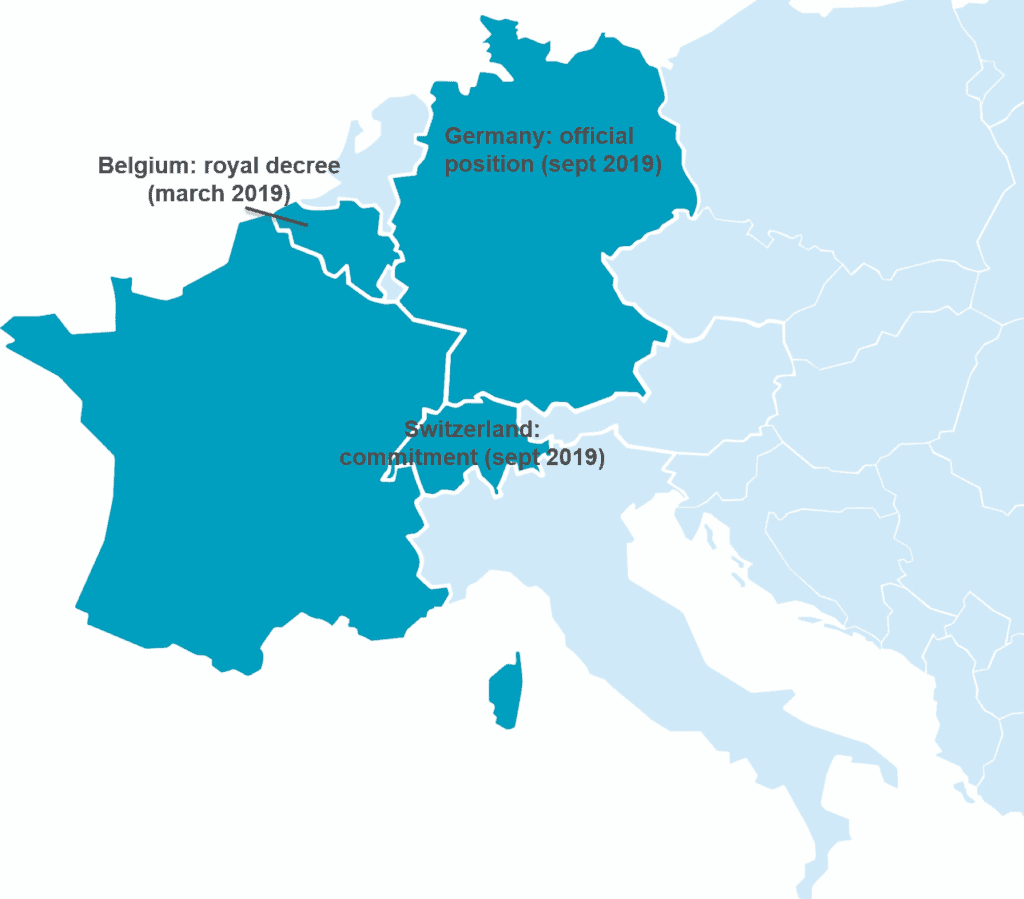The Nutri-Score label is helping consumers make nutritious choices when filling their shopping baskets, and encouraging food producers to improve the nutritional value of their products. But what is Nutri-Score? How was it developed and how is the score calculated? Pauline Ducrot from Santé publique France, the French national public health agency, explains the history and future of this initiative, which is quickly spreading across Europe.
By Pauline Ducrot
Veuillez cliquer ici pour lire cet article en Français.
What is Nutri-Score?

Nutri-Score is a nutritional label based on a five-colour coded scale going from dark green to dark orange, associated with letters from A to E. Dark green and the letter A is attached to products with the best nutritional quality, while dark orange and the letter E is attached to products with the lowest nutritional quality. Nutri-Score equips consumers with information about the general nutritional quality of products on the front of packaging. The underlying nutritional scoring method was developed by the British Food Standard Agency and is known as the ‘FSA score’. This score, which goes from -15 to 40, allows us to evaluate the overall nutritional quality of food. Based on 100g of product, it incorporates unfavourable factors such as calories (kj), saturated fatty acids (g), sugars (g), and sodium (mg); and favourable factors such as protein (g) fibre (g), and fruits, vegetables, legumes, nuts, and olive, nut, and colza oils (%).
There are two objectives when using Nutri-Score: supporting consumers, and encouraging the improvement of products. By giving access to information and helping people to compare products at a glance, consumers are pointed towards products with the best nutritional quality. At the same time, producers are encouraged to improve the quality of their products through reformulation and innovation.
A solid scientific base
Nutri-Score (or 5-colour label in the initial conception of the idea) was proposed based on scientific knowledge in the field, and the recommendations of different international committees of experts. Both the symbol and the system of calculation have undergone rigorous scientific evaluation.
The compatibility of the FSA score with French nutritional recommendations was validated (1-3), and different studies have evaluated the prospective relationships between the FSA score and indicators of health (i.e. Body Mass Index (BMI)), chronic diseases (i.e. cancer) and even the risks of mortality associated with them. (4-10)
The effectiveness of Nutri-Score has also been positively evaluated in studies assessing perception and comprehension (11-16), and on the impact of food choices. (17-20)
Take-up in France
The idea of a nutritional label on the front of packaging was proposed back in 2014 by professor Hercberg in a report for the Ministry of health which proposed several measures to bring new momentum to nutritional policy in France.
In January 2016, the proposition was taken up and integrated into the French act on modernising the health system. In order to select the label that would be officially supported by the public authorities, a randomised control trial comparing four labels was conducted in real-world conditions. The Nutri-Score label proved to be the most effective in improving the quality of people’s shopping carts. It was therefore selected as the official label with an official decree signed on 31st October 2017 by the Minister of solidarity and health, the Minister of agriculture, and the secretary of state to the Minister of economy and finance.
The use of the Nutri-Score label is still voluntary. Now two years after its launch, 250 brands are engaged in France – representing 25% of the French market.
The deployment of Nutri-Score on supermarket aisles and in ‘click and collect’ services has contributed greatly to consumers’ awareness of the label. In May 2019, 81% of consumers said they recognised Nutri-Score. The wider deployment also translates into an increase in the number of people who have purchased a product with Nutri-Score: 4 in 10 French people said they have already bought a product with the label.
Launch across Europe

Following France, several European countries have joined the movement: Belgium in March 2019, Switzerland and Germany in September 2019, and the Netherlands in November 2019. In addition, Nutri-Score is being used by some supermarket brands, such as Auchan in Portugal and Eroski in Spain. In fact, as the label has been registered as a trade-mark in Europe, it can be used across the territory.
In the interest of transparency towards consumers and coherence on the European market, France hopes that Nutri-Score will become obligatory in Europe. That’s the objective of the new initiative ‘pro Nutri-Score’ which was launched in May 2019 by seven consumer organisations. They aim to raise a million signatures from at least seven European Countries – if they are successful, this proposition will be evaluated by the European Commission.
To sign the initiative petition, visit eci.ec.europa.eu/009/public/#/initiative
Bibliography
- Julia C, Ducrot P, Peneau S, Deschamps V, Mejean C, Fezeu L, et al. Discriminating nutritional quality of foods using the 5-Color nutrition label in the French food market: consistency with nutritional recommendations. Nutrition journal. 2015;14:100.
- Julia C, Kesse-Guyot E, Ducrot P, Peneau S, Touvier M, Mejean C, et al. Performance of a five category front-of-pack labelling system – the 5-colour nutrition label – to differentiate nutritional quality of breakfast cereals in France. BMC public health. 2015;15:179.
- Julia C, Kesse-Guyot E, Touvier M, Mejean C, Fezeu L, Hercberg S. Application of the British Food Standards Agency nutrient profiling system in a French food composition database. The British journal of nutrition. 2014;112(10):1699-705.
- Adriouch S, Julia C, Kesse-Guyot E, Ducrot P, Peneau S, Mejean C, et al. Association between a dietary quality index based on the food standard agency nutrient profiling system and cardiovascular disease risk among French adults. International journal of cardiology. 2017;234:22-7.
- Adriouch S, Julia C, Kesse-Guyot E, Mejean C, Ducrot P, Peneau S, et al. Prospective association between a dietary quality index based on a nutrient profiling system and cardiovascular disease risk. European journal of preventive cardiology. 2016;23(15):1669-76.
- Deschasaux M, Julia C, Kesse-Guyot E, Lecuyer L, Adriouch S, Mejean C, et al. Are self-reported unhealthy food choices associated with an increased risk of breast cancer? Prospective cohort study using the British Food Standards Agency nutrient profiling system. BMJ open. 2017;7(6):e013718.
- Donnenfeld M, Julia C, Kesse-Guyot E, Mejean C, Ducrot P, Peneau S, et al. Prospective association between cancer risk and an individual dietary index based on the British Food Standards Agency Nutrient Profiling System. The British journal of nutrition. 2015;114(10):1702-10.
- Egnell M, Crosetto P, d’Almeida T, Kesse-Guyot E, Touvier M, Ruffieux B, et al. Modelling the impact of different front-of-package nutrition labels on mortality from non-communicable chronic disease. The international journal of behavioral nutrition and physical activity. 2019;16(1):56.
- Julia C, Ducrot P, Lassale C, Fezeu L, Mejean C, Peneau S, et al. Prospective associations between a dietary index based on the British Food Standard Agency nutrient profiling system and 13-year weight gain in the SU.VI.MAX cohort. Preventive medicine. 2015;81:189-94.
- Julia C, Fezeu LK, Ducrot P, Mejean C, Peneau S, Touvier M, et al. The Nutrient Profile of Foods Consumed Using the British Food Standards Agency Nutrient Profiling System Is Associated with Metabolic Syndrome in the SU.VI.MAX Cohort. The Journal of nutrition. 2015;145(10):2355-61.
- Ducrot P, Méjean C, Julia C, Kesse-Guyot E, Touvier M, Fezeu L, et al. Effectiveness of front-of-pack nutrition labels in French adults: results from the NutriNet-Sante cohort study. PLoS One. 2015;10(10):e0140898.
- Ducrot P, Mejean C, Julia C, Kesse-Guyot E, Touvier M, Fezeu LK, et al. Objective Understanding of Front-of-Package Nutrition Labels among Nutritionally At-Risk Individuals. Nutrients. 2015;7(8):7106-25.
- Egnell M, Ducrot P, Touvier M, Alles B, Hercberg S, Kesse-Guyot E, et al. Objective understanding of Nutri-Score Front-Of-Package nutrition label according to individual characteristics of subjects: Comparisons with other format labels. PLoS One. 2018;13(8):e0202095.
- Egnell M, Talati Z, Hercberg S, Pettigrew S, Julia C. Objective understanding of front-of-package nutrition labels: An international comparative experimental study across 12 countries. Nutrients. 2018;10(10):1542.
- Julia C, Peneau S, Buscail C, Gonzalez R, Touvier M, Hercberg S, et al. Perception of different formats of front-of-pack nutrition labels according to sociodemographic, lifestyle and dietary factors in a French population: cross-sectional study among the NutriNet-Sante cohort participants. BMJ open. 2017;7(6):e016108.
- Nugier A, Serry A, Thanh V. Système d’information nutritionnelle à cinq couleurs sur la face avant des emballages alimentaires: comparaison de trois formats de logo. Bulletin Epidémiologique Hebdomadaire. 2016;2016(34):598-607.
- Crosetto P, Muller L, Ruffieux B. Réponses des consommateurs à trois systèmes d’étiquetage nutritionnel face avant. Cahiers de Nutrition et de Diététique. 2016;51(3):124-31.
- Ducrot P, Julia C, Mejean C, Kesse-Guyot E, Touvier M, Fezeu LK, et al. Impact of Different Front-of-Pack Nutrition Labels on Consumer Purchasing Intentions: A Randomized Controlled Trial. American journal of preventive medicine. 2016;50(5):627-36.
- Egnell M, Kesse-Guyot E, Galan P, Touvier M, Rayner M, Jewell J, et al. Impact of Front-of-Pack Nutrition Labels on Portion Size Selection: An Experimental Study in a French Cohort. Nutrients. 2018;10(9).
- Julia C, Blanchet O, Mejean C, Peneau S, Ducrot P, Alles B, et al. Impact of the front-of-pack 5-colour nutrition label (5-CNL) on the nutritional quality of purchases: an experimental study. The international journal of behavioral nutrition and physical activity. 2016;13(1):101.

Pauline Ducrot
After having written a thesis on the effectiveness of nutritional labels, Pauline Ducrot is today the responsible for scientific studies at Public Health France.She advises companies on the use of Nutri-Score.
Après avoir étudié l’efficacité des logos nutritionnels durant sa thèse, Pauline Ducrot est aujourd’hui chargée d’études scientifiques à Santé publique France, et assure notamment l’appui technique aux entreprises engagées en faveur du Nutri-Score.
